Understand How Partners Can Adopt the Catalyst Delivery Methodology
Learning Objectives
After completing this unit, you’ll be able to:
- Understand how the API-led connectivity approach can help you to accelerate delivery.
- Use MuleSoft Catalyst to provide the process, best practices, and artifacts to enable API-led connectivity for customers.
- Get started with MuleSoft Catalyst resources.
MuleSoft Catalyst and Partner Adoption
MuleSoft Catalyst enables customers to adopt a unique, methodical approach to integration known as API-led connectivity. This approach allows you to connect data to applications through a series of modern, reusable APIs that are designed to play specific roles: unlock data from systems, compose data into processes, or deliver experiences to end users. And it’s about more than technology, shifting IT’s operating model and enabling the realization of the composable enterprise, one where its assets and services can be used independent of geographic or technical boundaries. Rather than creating one-off, brittle integrations with custom code, API-led connectivity enables discovering integration assets through self-service while maintaining the proper governance necessary across the organization.
MuleSoft Catalyst provides the process, best practices, and artifacts to enable API-led connectivity for customers, whether it be for a single project or a broader digital transformation initiative. With API-led connectivity, partners help customers deliver today’s projects quickly while building an agile infrastructure that accelerates follow-on projects. By leading with this approach, you can deliver far more value, speed, and agility to your customer, expanding your role from implementation provider to trusted advisor and change agent.
Imagine this scenario: A company wants to deliver multiple projects to improve its customer experience while improving operational efficiency across a large number of recently acquired brands. In the following diagram, we see that this company is tackling three distinct projects: digital transformation of multiple brands, customer experience refresh, and the acceleration of procurement approvals. Some of the data and applications overlap each other, a common scenario when building today’s connected digital experiences.

In our example above, the customer-facing mobile app needs to connect to SAP to get product data and to Salesforce Commerce Cloud to submit orders. With a traditional, legacy integration approach, you have to build custom point-to-point code, one project at a time. While this can meet the customer’s timeline and budget constraints, this legacy approach isn’t scalable. The custom code can’t be reused in future integration projects, resulting in duplicate work, increased costs, maintenance, and technical debt. And if configuration changes are necessary in the future, major portions of the code need to be rewritten.
Instead, you can build the SAP integration with API-led connectivity. The diagram below illustrates how each project uses the principle of reuse, increasing speed of delivery, standardization, and compounding customer value over time.

When delivering Project 1 shown here, APIs are created for common components, such as a Customer API exposing customer master information from Salesforce and a Product API exposing product data from SAP. API-led connectivity enables asset reuse, creating an infrastructure designed for change, compliance, governance, and business agility.
Driving an API-led approach has significant benefits for partners. The partner-customer relationship changes from a commodity, project-based one to a strategic partnership focused on driving organizational change, speed, and agility. MuleSoft partners who build expertise in MuleSoft Catalyst to employ this approach see significant benefits, including:
-
Increased revenue and longer-term customer engagements: Shift from single projects to an entire platform of work across multiple sustaining projects and initiatives.
-
Expanded scope in the role of Center for Enablement (C4E) service provider: Drive organizational change management and customer adoption in addition to delivery services.
-
Higher utilization rates across a flexible workforce: Empower your team to be skilled in a single platform and approach across a broad number of use cases and underlying technologies.
-
Strategic trusted advisor driving innovation at speed: Deliver 3x more speed and value to customers for the same budget as legacy approaches.
How You Can Get Involved
You’re already on the right path! The first step involves learning more about MuleSoft Catalyst, so be sure to check out all of the resources available, including a demo of Knowledge Hub in the next module. You should also consider reaching out to our MuleSoft partner team to learn more.
Second, our customers tell us that MuleSoft Catalyst is a unique and differentiating service, and now that we’re making it available to you, we encourage you to incorporate the MuleSoft Catalyst approach into your own selling and delivery methodology.
And finally, join the broader ecosystem. Learn from us and others, motivate existing customers, and share both what is working and what can be improved so that together we can all deliver the business outcomes that customers expect.

MuleSoft Catalyst is a great opportunity to expand your practice, changing your relationship from technology delivery provider to a strategic and trusted advisor. With systems integration services in high demand, coupled with a specific demand for MuleSoft Catalyst, the opportunity is available to accelerate customer digital transformation initiatives while growing your practice.